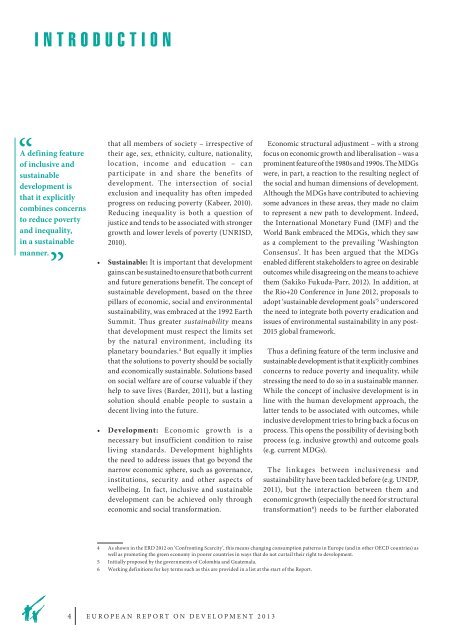Post 2015: Global Action for an Inclusive and Sustainable Future
Post 2015: Global Action for an Inclusive and Sustainable Future
Post 2015: Global Action for an Inclusive and Sustainable Future
Create successful ePaper yourself
Turn your PDF publications into a flip-book with our unique Google optimized e-Paper software.
InTRODuCTIOn<br />
A defining feature<br />
of inclusive <strong>an</strong>d<br />
sustainable<br />
development is<br />
that it explicitly<br />
combines concerns<br />
to reduce poverty<br />
<strong>an</strong>d inequality,<br />
in a sustainable<br />
m<strong>an</strong>ner.<br />
4<br />
that all members of society – irrespective of<br />
their age, sex, ethnicity, culture, nationality,<br />
location, income <strong>an</strong>d education – c<strong>an</strong><br />
participate in <strong>an</strong>d share the benefits of<br />
development. the intersection of social<br />
exclusion <strong>an</strong>d inequality has often impeded<br />
progress on reducing poverty (Kabeer, 2010).<br />
reducing inequality is both a question of<br />
justice <strong>an</strong>d tends to be associated with stronger<br />
growth <strong>an</strong>d lower levels of poverty (unrISD,<br />
2010).<br />
• <strong>Sustainable</strong>: It is import<strong>an</strong>t that development<br />
gains c<strong>an</strong> be sustained to ensure that both current<br />
<strong>an</strong>d future generations benefit. the concept of<br />
sustainable development, based on the three<br />
pillars of economic, social <strong>an</strong>d environmental<br />
sustainability, was embraced at the 1992 Earth<br />
Summit. thus greater sustainability me<strong>an</strong>s<br />
that development must respect the limits set<br />
by the natural environment, including its<br />
pl<strong>an</strong>etary boundaries. 4 but equally it implies<br />
that the solutions to poverty should be socially<br />
<strong>an</strong>d economically sustainable. Solutions based<br />
on social welfare are of course valuable if they<br />
help to save lives (barder, 2011), but a lasting<br />
solution should enable people to sustain a<br />
decent living into the future.<br />
• Development: Economic growth is a<br />
necessary but insufficient condition to raise<br />
living st<strong>an</strong>dards. Development highlights<br />
the need to address issues that go beyond the<br />
narrow economic sphere, such as govern<strong>an</strong>ce,<br />
institutions, security <strong>an</strong>d other aspects of<br />
wellbeing. In fact, inclusive <strong>an</strong>d sustainable<br />
development c<strong>an</strong> be achieved only through<br />
economic <strong>an</strong>d social tr<strong>an</strong>s<strong>for</strong>mation.<br />
EuropE<strong>an</strong> rEport on DEvElopmEnt 2013<br />
Economic structural adjustment – with a strong<br />
focus on economic growth <strong>an</strong>d liberalisation – was a<br />
prominent feature of the 1980s <strong>an</strong>d 1990s. the mDGs<br />
were, in part, a reaction to the resulting neglect of<br />
the social <strong>an</strong>d hum<strong>an</strong> dimensions of development.<br />
although the mDGs have contributed to achieving<br />
some adv<strong>an</strong>ces in these areas, they made no claim<br />
to represent a new path to development. Indeed,<br />
the International monetary Fund (ImF) <strong>an</strong>d the<br />
World b<strong>an</strong>k embraced the mDGs, which they saw<br />
as a complement to the prevailing ‘Washington<br />
consensus’. It has been argued that the mDGs<br />
enabled different stakeholders to agree on desirable<br />
outcomes while disagreeing on the me<strong>an</strong>s to achieve<br />
them (Sakiko Fukuda-parr, 2012). In addition, at<br />
the rio+20 conference in June 2012, proposals to<br />
adopt ‘sustainable development goals’ 5 underscored<br />
the need to integrate both poverty eradication <strong>an</strong>d<br />
issues of environmental sustainability in <strong>an</strong>y post-<br />
<strong>2015</strong> global framework.<br />
thus a defining feature of the term inclusive <strong>an</strong>d<br />
sustainable development is that it explicitly combines<br />
concerns to reduce poverty <strong>an</strong>d inequality, while<br />
stressing the need to do so in a sustainable m<strong>an</strong>ner.<br />
While the concept of inclusive development is in<br />
line with the hum<strong>an</strong> development approach, the<br />
latter tends to be associated with outcomes, while<br />
inclusive development tries to bring back a focus on<br />
process. this opens the possibility of devising both<br />
process (e.g. inclusive growth) <strong>an</strong>d outcome goals<br />
(e.g. current mDGs).<br />
the linkages between inclusiveness <strong>an</strong>d<br />
sustainability have been tackled be<strong>for</strong>e (e.g. unDp,<br />
2011), but the interaction between them <strong>an</strong>d<br />
economic growth (especially the need <strong>for</strong> structural<br />
tr<strong>an</strong>s<strong>for</strong>mation 6 ) needs to be further elaborated<br />
4 as shown in the ErD 2012 on ‘confronting Scarcity’, this me<strong>an</strong>s ch<strong>an</strong>ging consumption patterns in Europe (<strong>an</strong>d in other oEcD countries) as<br />
well as promoting the green economy in poorer countries in ways that do not curtail their right to development.<br />
5 Initially proposed by the governments of colombia <strong>an</strong>d Guatemala.<br />
6 Working definitions <strong>for</strong> key terms such as this are provided in a list at the start of the report.

















